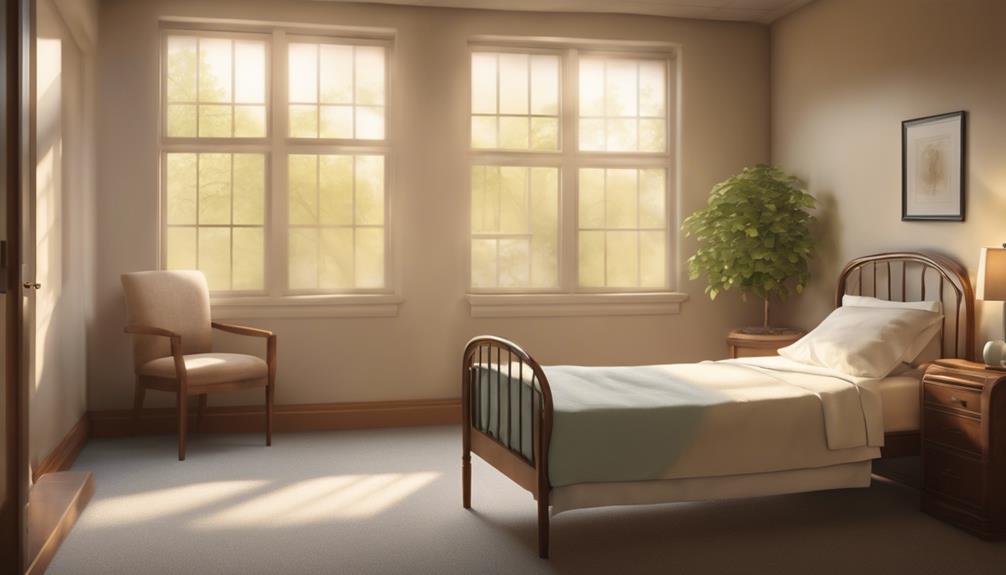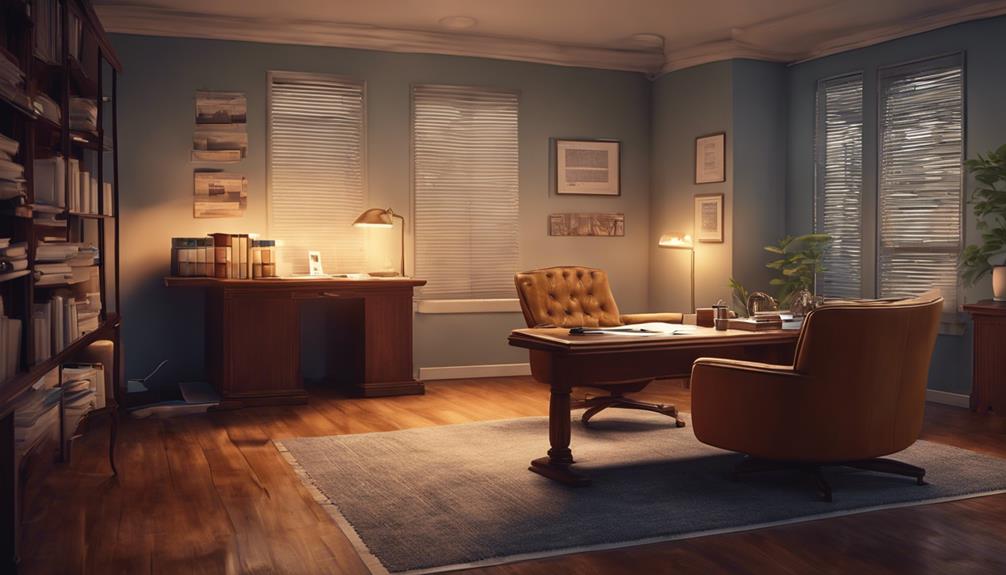Understanding who is responsible for covering the costs of hospice care and living expenses can be a challenging topic for many people. Although Medicare may not cover all of these expenses, Medicaid provides assistance to those who qualify based on financial eligibility criteria.
But what about private insurance options? Are there ways to offset these expenses without draining one's savings?
The landscape of payment options for hospice room and board is intricate, and understanding the intricacies is crucial for making informed decisions about end-of-life care.
Key Takeaways
- Medicare excludes room and board expenses for hospice care.
- Medicaid covers room and board for eligible hospice patients.
- Private insurance varies in coverage for hospice room and board.
- Financial assistance programs help ease hospice care costs.
Medicare Coverage for Hospice Room and Board
When discussing Medicare coverage for hospice room and board, it's important to note that Medicare doesn't cover these expenses. While Medicare provides a range of services for individuals with terminal illnesses, room and board costs aren't part of the covered benefits.
However, Medicare does offer coverage for short-term inpatient care or respite care services if arranged by the hospice team. In cases where patients require inpatient care for symptom management, Medicare will cover these services when provided in a Medicare-approved facility.
For individuals needing respite care, Medicare allows occasional stays of up to 5 days, with only a 5% cost to the patient. It's crucial for families facing these situations to understand the limitations of Medicare coverage regarding hospice room and board.
In instances where financial assistance is necessary, Medicaid may cover room and board expenses if the patient meets the financial eligibility criteria. Understanding the nuances of Medicare coverage for hospice care is essential in ensuring that individuals receive the necessary support during challenging times.
Medicaid Coverage for Hospice Room and Board

While Medicare doesn't cover room and board expenses for hospice care, Medicaid may provide coverage in certain situations, depending on individual financial eligibility. Medicaid plays a crucial role in ensuring that individuals receive the necessary care during their end-of-life journey.
Here are some key points to consider regarding Medicaid coverage for hospice room and board:
- Coverage for room and board varies by state and depends on individual financial eligibility.
- Medicaid typically covers room and board costs for hospice patients residing in nursing facilities.
- Eligibility for Medicaid coverage of room and board in hospice care is determined based on specific criteria.
- Hospice patients may qualify for Medicaid assistance to cover room and board expenses during their end-of-life care.
Understanding the Medicaid coverage available for hospice room and board can provide peace of mind for individuals and their families during a challenging time. It's essential to explore the criteria and assistance options provided by Medicaid to ensure that the necessary care is accessible when needed.
Private Insurance Options for Hospice Room and Board
Private insurance plans offer varying coverage options for room and board expenses related to hospice care, depending on the specific plan and policy in place. When it comes to hospice care, coverage through private insurance can include different out-of-pocket expenses and limitations. It's essential for patients to thoroughly review their private insurance policy to understand the extent of room and board coverage available for hospice care.
Some private insurance plans may have restrictions or requirements for room and board coverage in hospice care, such as pre-authorization or specific facility criteria. Patients should proactively reach out to their insurance provider to inquire about the details of room and board coverage under their specific plan. By understanding the coverage provided by their private insurance, individuals can better prepare for any potential expenses associated with hospice room and board, ensuring they receive the necessary care without added financial stress.
Out-of-Pocket Expenses for Hospice Room and Board

Navigating the financial aspect of hospice care can be daunting, especially when it comes to covering out-of-pocket expenses for room and board. When it comes to hospice room and board costs, it's crucial to understand the various payment responsibilities and options available. Here are some key points to consider:
- Medicare and most insurance plans typically don't cover room and board expenses in hospice care.
- Patients or their families may need to pay out-of-pocket for these costs.
- Medicaid could potentially cover room and board expenses for hospice patients who meet specific financial eligibility criteria.
- Some hospice providers offer financial assistance programs or sliding scale fees to help individuals with room and board expenses.
Before starting hospice care, it's essential to have a clear discussion with the hospice provider regarding the financial aspects, including room and board costs and any available assistance programs. Understanding these financial considerations can help alleviate some of the stress during an already challenging time.
Financial Assistance Programs for Hospice Room and Board
Understanding the financial assistance programs available for hospice room and board can provide much-needed support during a challenging time of navigating hospice care expenses. For those eligible, Medicaid may cover room and board costs, subject to state policies.
Certain private insurance plans offer coverage for room and board expenses, based on plan terms. Veterans receiving hospice care may have room and board costs covered by the Veterans Affairs (VA) benefits, eliminating additional out-of-pocket expenses.
Hospice providers conduct financial assessments for uninsured individuals to determine room and board costs and provide assistance programs. While Medicare typically doesn't cover room and board expenses, it may cover short-term inpatient or respite care services in specific situations.
These financial assistance options aim to ease the burden of room and board expenses for individuals and families facing end-of-life care, ensuring that quality hospice services are accessible and affordable when needed the most.
Frequently Asked Questions
What Is the Main Source of Payment for Hospice Care?
When looking at hospice care, the main source of payment typically comes from Medicare. This program covers many aspects of hospice services, such as medical supplies and nursing care.
However, it's important to note that room and board expenses aren't included in this coverage. Patients are usually responsible for these costs, unless they've Medicaid or private insurance that may offer some assistance in specific situations.
What Is Usually Not Included in Hospice Care?
When considering what's usually not included in hospice care, it's important to note that room and board costs, rent or mortgage payments, food expenses for patients at home, and room fees in assisted living facilities are typically not covered.
Additionally, emergency department care unrelated to the terminal diagnosis and curative treatments with related prescription drugs are excluded from hospice care coverage.
These exclusions can add financial burdens during an already challenging time.
Does Medicare Pay if the Patient Is in Hospice?
Medicare can cover some hospice services, like short-term inpatient care or respite care, arranged through the hospice team. Inpatient care, for symptom management, is provided in a Medicare-approved facility.
Respite care allows occasional stays up to 5 days, with a 5% patient cost. Skilled nursing facility residents can elect hospice under certain conditions. These options can help support patients and families during challenging times.
Do You Get Your Own Room in a Hospice?
In a hospice setting, patients typically receive a private room for comfort and privacy during their stay. Room arrangements can vary based on availability and individual preferences.
While room and board costs are usually not covered by Medicare or most insurance plans, patients may need to cover these expenses out-of-pocket or through Medicaid if eligible. Discussing room options and associated costs with the hospice staff can clarify available choices and financial responsibilities.
Conclusion
As we navigate the delicate journey of hospice care, it's important to remember that the cost of room and board can vary depending on coverage options.
While Medicare and Medicaid may offer some assistance, private insurance and financial assistance programs can also provide relief.
Ultimately, like a guiding light in the darkness, these resources can help ease the burden of expenses, allowing us to focus on what truly matters during this challenging time.









